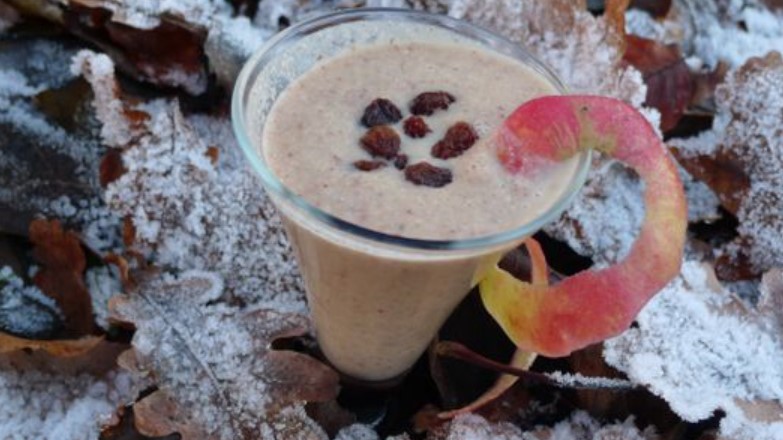Delicious winter smoothies can also be mixed from “winter vegetables”. Here are three delicious smoothie recipes with seasonal fruit and vegetables.
Of course, citrus fruits in particular are everywhere in winter, but they have come a long way. Tropical fruits are also delicious, but ecologically not sensible.
Instead, there are enough fruits and vegetables from local cultivation or from your own cellar to make healthy smoothies. Our winter smoothie recipes are based on the Utopia seasonal calendar. In it you can read when which fruit and vegetables are in season with us.
We have three simple recipes for you that require few ingredients, are therefore quick to prepare and are suitable for any time of the day. So that the fat-soluble vitamins can also be absorbed by the body, you should never omit the nuts.
Winter Smoothie Recipe #1: Spicy Beetroot

You only need a few ingredients for a smoothie that warms you from the inside with the spicy spiciness of ginger:
1 medium sized beetroot
1 large pear
1 piece of ginger
1 handful of hazelnuts
some water
How to prepare the winter smoothie:
Peel the beetroot and cut into pieces. Because the red juice stains strongly, it is better to wear gloves when processing the tuber or rub your fingers with lemon juice afterwards. Remove the core of the pear and peel the piece of ginger.
Now add water to taste and process all the ingredients into a creamy smoothie. The more ginger you use, the more warming the winter smoothie will be.
Tip: You can also use nut oil instead of grated hazelnuts. Simply add your nut oil of choice while blending so it emulsifies well. If you use roasted oil, the nut aroma is more intense.
Beetroot bulbs can weigh up to 600 grams and can be stored very well. That’s why they are also considered “winter vegetables”, although their harvest takes place in summer from July. So there is no reason to only eat them in winter.
The vegetables contain a lot of vitamins and minerals, especially potassium, B vitamins, iron and folic acid. With manganese, copper and selenium, beetroot also provides rare but important trace elements.
However, beetroot also has quite a lot of oxalic acid. Anyone who tends to form kidney stones should avoid excessive consumption of the red tuber.
Beetroot is also a good nitrate storer. Nitrates are used as fertilizer in agriculture and can be converted into toxic nitrite. If the field is over-fertilized, a relatively large amount of nitrate is stored in the beetroot. To minimize this risk, you should only buy organic beetroot.
Winter Smoothie Recipe #2: Winter Apple

Apples are a native fruit that is available to us practically all year round. They contain a lot of soluble and insoluble fiber such as pectins. Pectins are water soluble and cannot be seen with the naked eye.
Dietary fiber promotes digestion. They are also said to be helpful in preventing colon cancer. There is evidence that a high-fiber breakfast can directly or indirectly lower cholesterol levels. Tip: It is best to eat apples in their most natural form – as a whole fruit with skin.
The taste of this smoothie is reminiscent of baked apple. You need:
1 large apple
50 grams of raisins
1 handful of hazelnuts
Cinammon
some water
Here’s how to enjoy the winter smoothie for breakfast:
Soak the raisins in water the night before.
The next morning, remove the core of the apple. Then put the apple in the blender with the raisins, the soaking water and the hazelnuts.
If the raisins aren’t soaking in enough water to make them drinkable, add a little more water. Season with cinnamon and enjoy immediately.
In case you forgot to soak the raisins the night before, they will swell faster if you pour hot water over them. The better the raisins are soaked, the less power your blender will need. You can then also make the smoothie with a regular hand blender.
Smoothie Recipe #3: Fresh with lamb’s lettuce

Lamb’s lettuce also grows outdoors in winter in sheltered locations or under fleece. Not only in the cold months it is a good alternative to lettuce from greenhouses or southern growing areas.
Tip: If you don’t have any lamb’s lettuce at hand, you can also use other “winter salads” such as winter purslane, which is also called postelein.
For the green winter smoothie you need:
125 g lamb’s lettuce
1 large apple
1 tbsp walnuts
some water
How to prepare the winter smoothie:
Wash and clean the lamb’s lettuce well and cut the core out of the apple.
Put the apple and lettuce in a blender with a little water or use an immersion blender to make a green smoothie.
Roughly chop the walnuts and sprinkle over the smoothie. Do not puree with the other ingredients, the bitter substances in the walnuts would literally “bitter” the smoothie.
Tip: The smoothie recipe also tastes good with cress instead of lamb’s lettuce. In winter you can simply grow cress yourself on the window sill. You don’t need any special equipment for this: a plate and some kitchen paper are all you need to grow your own salad in the kitchen.
